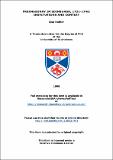Files in this item
Freemasonry in Edinburgh, 1721-1746 : institutions and context
Item metadata
| dc.contributor.advisor | Stevenson, David | |
| dc.contributor.advisor | Mason, Roger A. | |
| dc.contributor.author | Kahler, Lisa | |
| dc.coverage.spatial | 370 | en |
| dc.date.accessioned | 2008-04-07T09:01:17Z | |
| dc.date.available | 2008-04-07T09:01:17Z | |
| dc.date.issued | 1998 | |
| dc.identifier.uri | https://hdl.handle.net/10023/461 | |
| dc.description.abstract | It was not until after the mid-eighteenth century that the masonic lodges in Edinburgh became common meeting ground for the social and intellectual elite. While there are examples of these types of men joining before 1750, it was after this watershed date that some of the key men associated with enlightenment thinking in Scotland became members of Edinburgh lodges. Robert Adam, Hugh Blair, Lord Monboddo, James Gregory, Henry Mackenzie and Dugald Stewart are only a few examples of men who made a dual contribution to both freemasonry and the enlightenment. 'Freemasonry in Edinburgh, 1721-1746 : institutions and context' is an examination of freemasonry in Edinburgh before the dramatic influx of the elite. It was during this period that three major developments occurred: existing lodges began the slow transition from traditional operative lodges to the more modern, accepted lodges; lodges were being founded with little or no connection to stonemasons or stoneworks; and, the Grand Lodge of Scotland was established, creating a definite masonic community both within and outwith Edinburgh. This thesis charts the progress of the transition in nine Edinburgh lodges by examining both the histories and membership of these lodges, and considers the influence of the Grand Lodge of Scotland on this process. The key element in this transitional process was the membership. A total of 785 men are known to have joined, or belonged to, these lodges during this period. These men represented occupations from the advocate to the humble wine cooper's servant, and social circumstances from the baronet to the indweller. This membership analysis was the most important area of research because it illustrated the transition in the lodges. Using 30 November 1736, the date that the Grand Lodge Roll began, as a watershed date, it is possible to establish the membership of the lodges during the entire period of study, and to compare the membership of pre-Grand Lodge lodges both before and after the establishment of the Grand Lodge of Scotland. | en |
| dc.format.extent | 23493610 bytes | |
| dc.format.mimetype | application/pdf | |
| dc.language.iso | en | en |
| dc.publisher | University of St Andrews | |
| dc.rights | Creative Commons Attribution-NonCommercial-NoDerivs 3.0 Unported | |
| dc.rights.uri | http://creativecommons.org/licenses/by-nc-nd/3.0/ | |
| dc.subject.lcc | HS597.K2 | |
| dc.subject.lcsh | Freemasonry--Scotland--Edinburgh--History--18th century | en |
| dc.title | Freemasonry in Edinburgh, 1721-1746 : institutions and context | en |
| dc.type | Thesis | en |
| dc.type.qualificationlevel | Doctoral | en |
| dc.type.qualificationname | PhD Doctor of Philosophy | en |
| dc.publisher.institution | The University of St Andrews | en |
This item appears in the following Collection(s)
Except where otherwise noted within the work, this item's licence for re-use is described as Creative Commons Attribution-NonCommercial-NoDerivs 3.0 Unported
Items in the St Andrews Research Repository are protected by copyright, with all rights reserved, unless otherwise indicated.


